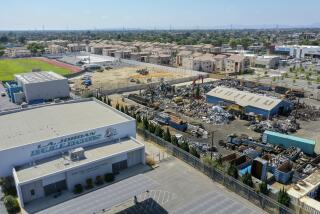Salvage Operator May Face Prosecution
State toxic waste officials asked the Orange County district attorney’s office Wednesday to consider criminal prosecution of an Anaheim salvage operator for stockpiling residue from shredded cars and appliances that contains highly toxic PCBs.
Deputy Dist. Atty. Diane Stavenhagen Kadletz said that she will review the case against Orange County Steel Salvage Inc. with Anaheim Deputy City Atty. Mark Logan and that they will decide within a few weeks whether there is sufficient evidence for prosecution.
Under the California Hazardous Waste Control Act, Kadletz said, it is a misdemeanor to store hazardous waste for more than 90 days without a state permit. The law also requires that such material be stored properly in containers. At Orange County Steel Salvage, it is stored in a 40-foot-high, 400-foot-long pile.
George Adams Jr., owner of the company, has been accumulating the waste, known in the industry as “fluff,” at the rate of 2,000 tons a month since July, 1984, while trying to win legislative approval to dump it in ordinary landfills.
Operator Could Be Fined
If charges are filed against Orange County Steel Salvage, Kadletz said, Adams could face fines of up to $25,000 a day.
“I don’t know what they are trying to accomplish,” Adams said Wednesday in reference to officials of the state Department of Health Services toxic substances control unit who referred the case for prosecution. “But I don’t think it’s very constructive.”
“If they think it’s going to make me move it faster, they’re wrong,” Adams said, contending that he cannot afford to haul the estimated 40,000 tons of waste to an approved dump.
“The bottom line is this: I did not put one bit of hazardous waste in that pile because it’s already in the appliances when I get them,” he declared.
In 1982, California became the only state to classify “fluff” as marginally hazardous waste because of the low levels of lead and other metals clinging to the remains of car seats, carpets and other items. The concern was that lead oxide could leach from a landfill, contaminating underground water supplies.
A new law allows “fluff” to be put in ordinary landfills, but the law does not preclude regional water quality control boards from imposing conditions. Area boards have said that landfills can accept “fluff” if it is stored separately in lined pits that are monitored for leaks.
(Other Southern California automobile shredders are continuing to haul their waste out of state, authorities said.)
Choices Appear Limited
Now that PCBs, or polychlorinated biphenyls, suspected carcinogens banned since the late 1970s, have been found in the waste pile at the yard in northeastern Anaheim, Adams’ choices for disposal appear to be severely limited.
Adams has said he would abandon the waste, leaving it for the state to handle, rather than pay $150 a ton to dispose of it at a Class I facility for hazardous waste.
Health officials have said the PCBs at Adams’ yard pose no immediate health threat, but local water officials remain concerned because the pile is located near the Santa Ana River and a major underground water basin.
Initially, state health officials said that they suspected Adams of illegally shredding electrical transformer boxes containing PCBs. However, James McNally, who is overseeing state enforcement and cleanup action against the firm, said Wednesday that small amounts of PCBs were allowed in electrical capacitors in household appliances before 1979.
Adams said that 50% of his business was in old appliances. Last week, he stopped accepting them, however, after learning that they are a likely source of PCBs. Orange County landfills also began to refuse old appliances when Adams told county officials that they contain PCBs.
Orange County Waste Management Director Francis R. Bowerman said he lifted the ban Wednesday after health officials in Sacramento said that appliances are household waste, which is exempt from state hazardous-waste laws.
McNally referred the case for prosecution because, he said, Adams, despite repeated warnings, “has just not taken any constructive steps to manage that waste pile according to the law.”
But McNally said efforts to remove the waste pile will continue.
“Regardless of the district attorney’s decision to file or not,” McNally said, “we intend to move ahead with our plans to either have Adams clean up the site or take the necessary steps to encumber the state funds to do it.”
More to Read
Sign up for Essential California
The most important California stories and recommendations in your inbox every morning.
You may occasionally receive promotional content from the Los Angeles Times.









